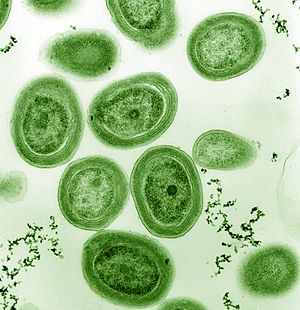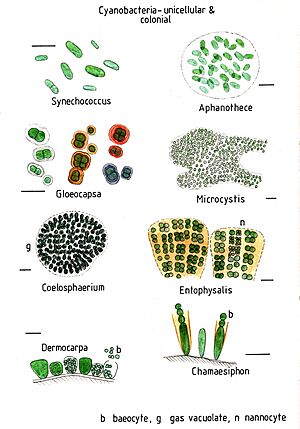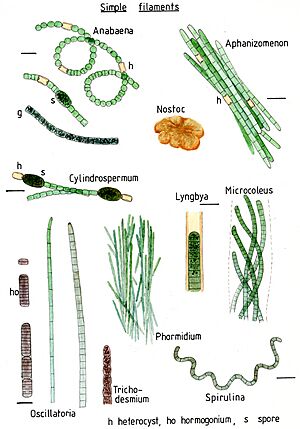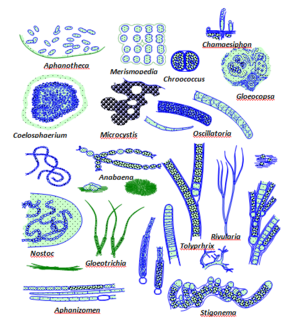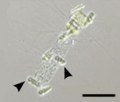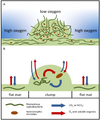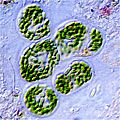Cyanobacteria facts for kids
Quick facts for kids CyanobacteriaTemporal range: 2100–0Ma
(Possible Paleoarchean records)
|
|
|---|---|
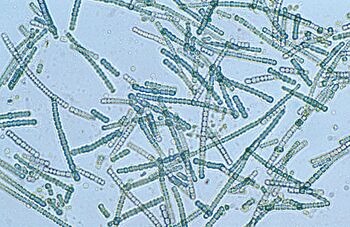 |
|
| Microscope image of Cylindrospermum, a filamentous genus of cyanobacteria | |
| Scientific classification |
|
| Unrecognized taxon (fix): | Cyanobacteriota |
| Classes and genera | |
|
|
| Synonyms | |
|
List
Chloroxybacteria Margulis & Schwartz, 1982
"Cyanobacteria" Woese et al., 1985 "Cyanophycota" Parker, Schanen & Renner, 1969 "Cyanophyta" Steinecke, 1931 "Diploschizophyta" Dillon, 1963 "Endoschizophyta" Dillon, 1963 "Exoschizophyta" Dillon, 1963 Gonidiophyta Schaffner, 1909 "Phycobacteria" Cavalier-Smith, 1998 Phycochromaceae Rabenhorst, 1865 Prochlorobacteria Jeffrey, 1982 Prochlorophycota Shameel, 2008 Prochlorophyta Lewin, 1976 Chroococcophyceae Starmach, 1966 Chamaesiphonophyceae Starmach, 1966 Cyanobacteriia Cyanophyceae Sachs, 1874 Cyanophyta Steinecke, 1931 Hormogoniophyceae Starmach, 1966 Myxophyceae Wallroth, 1833 Nostocophyceae Christensen, 1978 Pleurocapsophyceae Starmach, 1966 Prochlorophyceae Lewin, 1977 Scandophyceae Vologdin, 1962 Phycochromaceae Rabenhorst, 1865 Oxyphotobacteria Gibbons & Murray, 1978 Schizophyceae Cohn, 1879 |
|
Cyanobacteria are a group of bacteria that can make their own energy from sunlight. They are also known by their common name, blue-green algae, because of their color and where they live. However, they are not actually algae; they are bacteria.
These tiny organisms are very important in the history of Earth. They were the first living things to produce oxygen through a process called photosynthesis. Before cyanobacteria appeared billions of years ago, there was almost no oxygen in Earth's atmosphere. By releasing oxygen over a long time, they changed the air and made it possible for animals and humans to exist today.
Cyanobacteria can be found almost everywhere on Earth, including oceans, fresh water, damp soil, and even on rocks in deserts.
Contents
What Cyanobacteria Look Like
Cyanobacteria are microscopic, meaning they are too small to be seen with just your eyes. However, they often grow together in large groups called colonies, which can be seen easily.
Shapes and Forms
These bacteria come in different shapes:
- Unicellular: Some live as single cells.
- Filamentous: Many form long chains of cells that look like threads or filaments.
- Colonial: Some group together in jelly-like blobs.
Some filamentous types have special cells that do specific jobs. For example, they might have a thick-walled cell called a heterocyst that helps them turn nitrogen from the air into nutrients. Others have spore-like cells called akinetes that help them survive harsh weather.
How They Changed Earth

Cyanobacteria have a very long history. Fossils show they have been on Earth for at least 2.1 billion years, and possibly as long as 3.5 billion years.
The Great Oxygen Event
A long time ago, Earth's atmosphere had no oxygen that animals could breathe. When cyanobacteria evolved, they started using sunlight to make food from water and carbon dioxide. This process releases oxygen as a byproduct.
For millions of years, these bacteria pumped oxygen into the ocean and the air. This is called the Great Oxidation Event. This change allowed new types of life to evolve, eventually leading to the plants and animals we see today.
Origin of Plants
Scientists believe that the chloroplasts found in plants today—the parts of plant cells that make them green and allow them to do photosynthesis—actually evolved from ancient cyanobacteria. Long ago, a larger cell likely "swallowed" a cyanobacterium but did not digest it. Instead, they lived together, and over time, the cyanobacterium became the chloroplast.
How They Live
Cyanobacteria are autotrophs, which means "self-feeders." They do not need to eat other organisms to survive.
Photosynthesis
Just like plants, cyanobacteria use a green pigment called chlorophyll to capture sunlight. They also have other pigments that give them their blue-green color. They use this light energy to turn water and carbon dioxide into sugars for food. This process releases oxygen, which is vital for life on Earth.
Nitrogen Fixation
All living things need nitrogen to build proteins. Although there is a lot of nitrogen in the air, most organisms cannot use it directly. Some cyanobacteria have the special ability to "fix" nitrogen. This means they can take nitrogen gas from the air and turn it into a form that plants and other living things can use. This makes them very important for the health of soil and water ecosystems.
Where They Live
Cyanobacteria are very tough and can live in many different environments.
- Water: They are very common in oceans, lakes, and ponds. In the ocean, tiny cyanobacteria like Prochlorococcus produce a huge amount of the oxygen we breathe.
- Land: They grow in damp soil and can form crusts on desert sand that stop erosion.
- Extreme Places: Some live in hot springs, while others live inside rocks in Antarctica.
- Symbiosis: Some live inside other organisms, like plants, fungi (forming lichen), or coral, helping their hosts by providing food or nitrogen.
Algal Blooms
Sometimes, when the water is warm and has lots of nutrients, cyanobacteria can grow very fast. This is called a "bloom." The water might look like it has green paint or scum floating on top.
While these blooms are natural, they can sometimes be harmful. They can block sunlight for other underwater plants and use up all the oxygen in the water when they die, which can harm fish.
Importance to Humans
Biotechnology and Food
People use cyanobacteria in many helpful ways:
- Food: Some types, like Spirulina, are safe to eat and are sold as healthy food supplements because they are rich in protein and vitamins.
- Energy: Scientists are studying how to use them to produce renewable fuels, like bioethanol.
- Agriculture: Because they fix nitrogen, they can be used as natural fertilizers in rice fields to help crops grow.
Safety and Toxins
Not all cyanobacteria are safe. Some species produce toxins (poisons) called cyanotoxins. If people or animals drink water with these toxins, they can get sick. This is why it is important not to swim in or drink from water that has a thick, smelly green scum.
Images for kids
See also
 In Spanish: Cyanobacteria para niños
In Spanish: Cyanobacteria para niños
- Archean Eon
- Endosymbiotic theory
- Geological history of oxygen
- Phytoplankton



